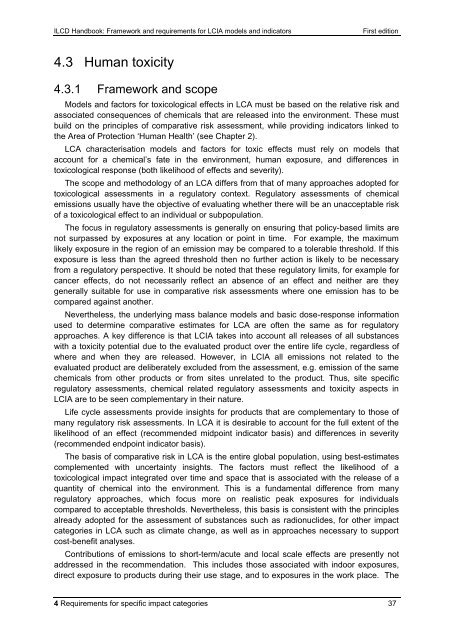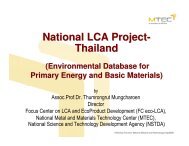ILCD Handbook: Framework and requirements for LCIA models and ...
ILCD Handbook: Framework and requirements for LCIA models and ...
ILCD Handbook: Framework and requirements for LCIA models and ...
Create successful ePaper yourself
Turn your PDF publications into a flip-book with our unique Google optimized e-Paper software.
<strong>ILCD</strong> <strong>H<strong>and</strong>book</strong>: <strong>Framework</strong> <strong>and</strong> <strong>requirements</strong> <strong>for</strong> <strong>LCIA</strong> <strong>models</strong> <strong>and</strong> indicators First edition<br />
4.3 Human toxicity<br />
4.3.1 <strong>Framework</strong> <strong>and</strong> scope<br />
Models <strong>and</strong> factors <strong>for</strong> toxicological effects in LCA must be based on the relative risk <strong>and</strong><br />
associated consequences of chemicals that are released into the environment. These must<br />
build on the principles of comparative risk assessment, while providing indicators linked to<br />
the Area of Protection ‗Human Health‘ (see Chapter 2).<br />
LCA characterisation <strong>models</strong> <strong>and</strong> factors <strong>for</strong> toxic effects must rely on <strong>models</strong> that<br />
account <strong>for</strong> a chemical‘s fate in the environment, human exposure, <strong>and</strong> differences in<br />
toxicological response (both likelihood of effects <strong>and</strong> severity).<br />
The scope <strong>and</strong> methodology of an LCA differs from that of many approaches adopted <strong>for</strong><br />
toxicological assessments in a regulatory context. Regulatory assessments of chemical<br />
emissions usually have the objective of evaluating whether there will be an unacceptable risk<br />
of a toxicological effect to an individual or subpopulation.<br />
The focus in regulatory assessments is generally on ensuring that policy-based limits are<br />
not surpassed by exposures at any location or point in time. For example, the maximum<br />
likely exposure in the region of an emission may be compared to a tolerable threshold. If this<br />
exposure is less than the agreed threshold then no further action is likely to be necessary<br />
from a regulatory perspective. It should be noted that these regulatory limits, <strong>for</strong> example <strong>for</strong><br />
cancer effects, do not necessarily reflect an absence of an effect <strong>and</strong> neither are they<br />
generally suitable <strong>for</strong> use in comparative risk assessments where one emission has to be<br />
compared against another.<br />
Nevertheless, the underlying mass balance <strong>models</strong> <strong>and</strong> basic dose-response in<strong>for</strong>mation<br />
used to determine comparative estimates <strong>for</strong> LCA are often the same as <strong>for</strong> regulatory<br />
approaches. A key difference is that <strong>LCIA</strong> takes into account all releases of all substances<br />
with a toxicity potential due to the evaluated product over the entire life cycle, regardless of<br />
where <strong>and</strong> when they are released. However, in <strong>LCIA</strong> all emissions not related to the<br />
evaluated product are deliberately excluded from the assessment, e.g. emission of the same<br />
chemicals from other products or from sites unrelated to the product. Thus, site specific<br />
regulatory assessments, chemical related regulatory assessments <strong>and</strong> toxicity aspects in<br />
<strong>LCIA</strong> are to be seen complementary in their nature.<br />
Life cycle assessments provide insights <strong>for</strong> products that are complementary to those of<br />
many regulatory risk assessments. In LCA it is desirable to account <strong>for</strong> the full extent of the<br />
likelihood of an effect (recommended midpoint indicator basis) <strong>and</strong> differences in severity<br />
(recommended endpoint indicator basis).<br />
The basis of comparative risk in LCA is the entire global population, using best-estimates<br />
complemented with uncertainty insights. The factors must reflect the likelihood of a<br />
toxicological impact integrated over time <strong>and</strong> space that is associated with the release of a<br />
quantity of chemical into the environment. This is a fundamental difference from many<br />
regulatory approaches, which focus more on realistic peak exposures <strong>for</strong> individuals<br />
compared to acceptable thresholds. Nevertheless, this basis is consistent with the principles<br />
already adopted <strong>for</strong> the assessment of substances such as radionuclides, <strong>for</strong> other impact<br />
categories in LCA such as climate change, as well as in approaches necessary to support<br />
cost-benefit analyses.<br />
Contributions of emissions to short-term/acute <strong>and</strong> local scale effects are presently not<br />
addressed in the recommendation. This includes those associated with indoor exposures,<br />
direct exposure to products during their use stage, <strong>and</strong> to exposures in the work place. The<br />
4 Requirements <strong>for</strong> specific impact categories 37



